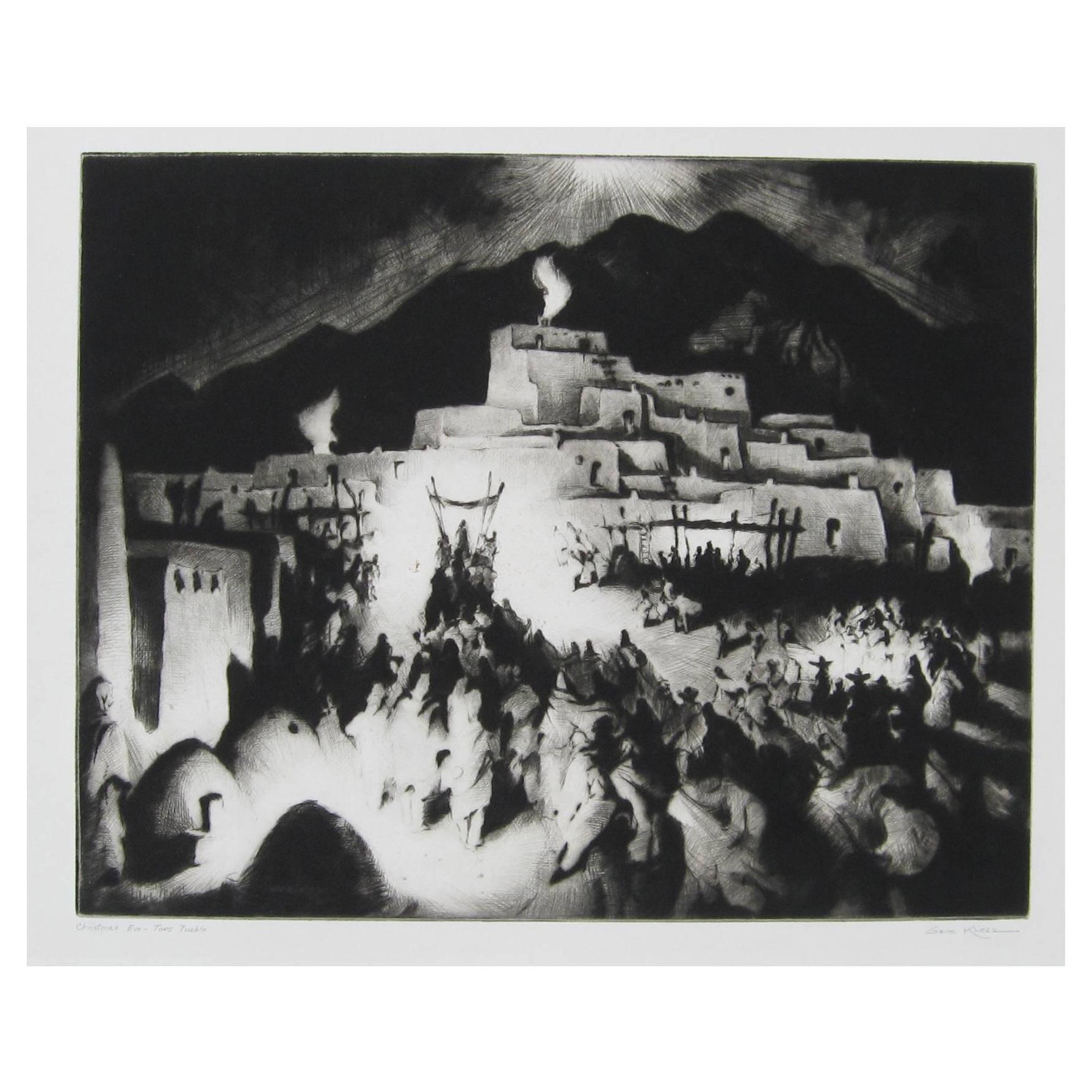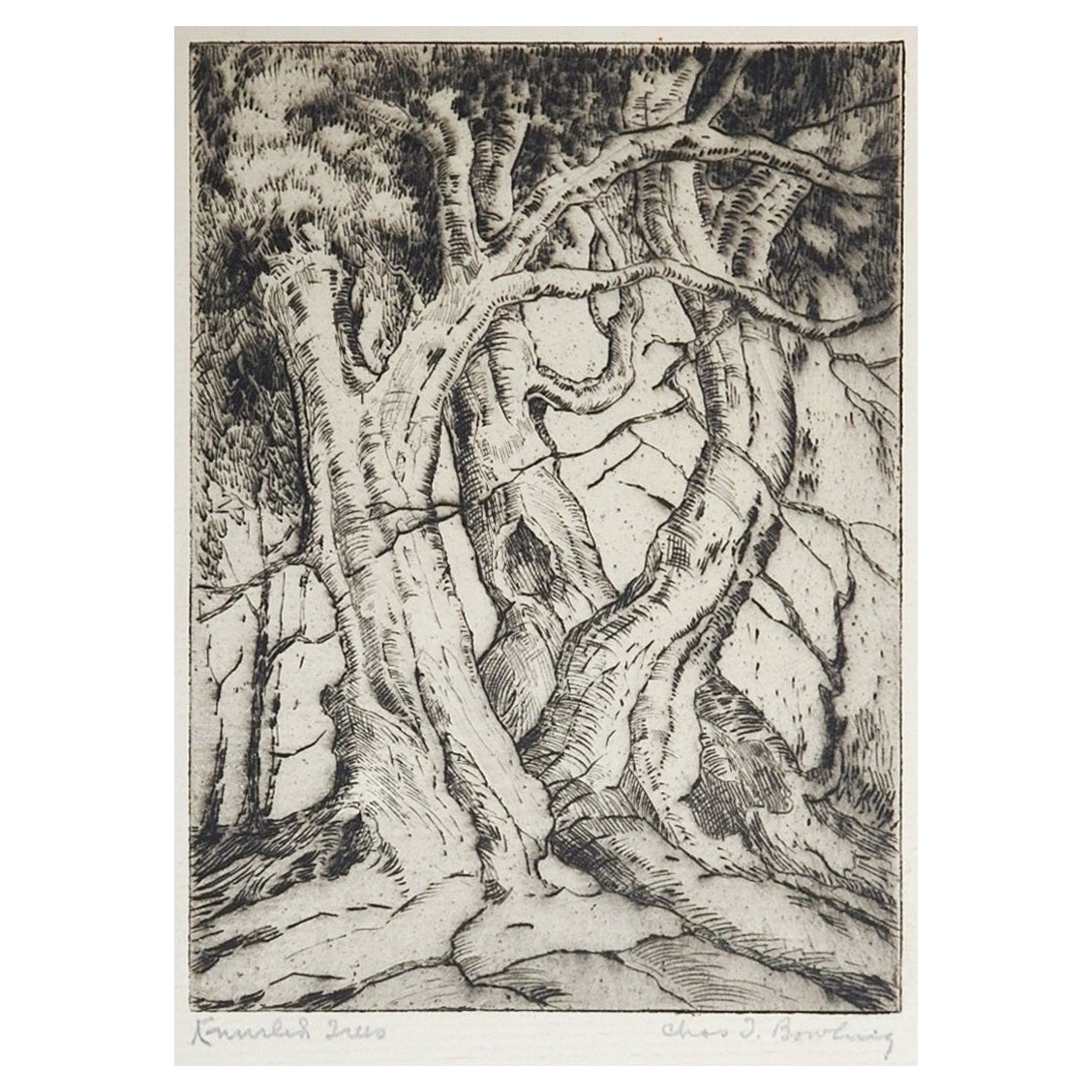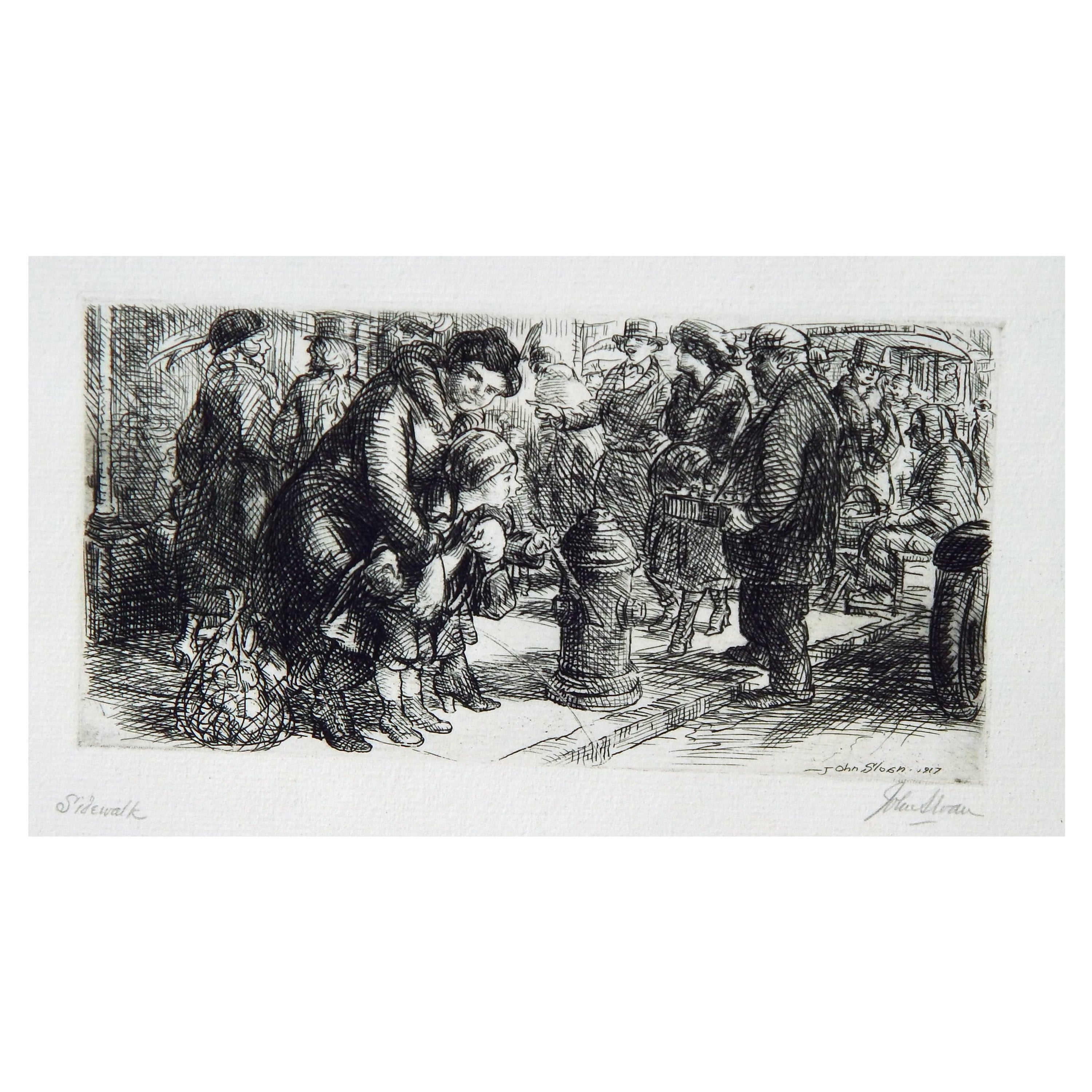Items Similar to Gene Kloss Original Etching, 1938 - "Pines at Point Lobos"
Want more images or videos?
Request additional images or videos from the seller
1 of 6
Gene Kloss Original Etching, 1938 - "Pines at Point Lobos"
About the Item
Etching on paper by famous Taos Artist Gene Kloss (1903-1996).
Titled: “Pines on Point Lobos.” Pencil signed lower right and in excellent condition.
Image measures: 9" H x 6.88" W. Sheet size is: 17 3/4"H x 14.5"W.
Unframed. Archivally matted in a 20 x 16 mat. Created 1938. Kloss #352.
Gene Kloss was born Alice Geneva Glasier in Oakland, California and studied at the University of California at Berkeley. She also studied at the California School of Fine Arts in San Francisco where she began etching in 1927.
In 1925 she married Phillips Kloss and visited Taos for the first time. She and Phillips divided their time between Berkeley and Taos, settling permanently in Taos in 1945.
During the Depression, Kloss was a resident of Taos and made prints for the PWAP and WPA/FAP in New Mexico. She maintained memberships in numerous organizations including the Society of American Etchers, Chicago Society of Etchers, California Society of Etchers, Carmel Art Association, Prairie Print Makers, New Mexico Art League and the Philadelphia Watercolor Club. She received numerous honors for her prints, which were included in Fine Prints of the Year and 100 Best Prints of the Year.
- Creator:Gene Kloss 1 (Artist)
- Dimensions:Height: 20 in (50.8 cm)Width: 16 in (40.64 cm)Depth: 0.06 in (1.53 mm)
- Materials and Techniques:
- Period:
- Date of Manufacture:1938
- Condition:
- Seller Location:Phoenix, AZ
- Reference Number:1stDibs: LU1875336463612
About the Seller
5.0
Gold Seller
These expertly vetted sellers are highly rated and consistently exceed customer expectations.
Established in 1988
1stDibs seller since 2016
323 sales on 1stDibs
Typical response time: 3 hours
- ShippingRetrieving quote...Ships From: Phoenix, AZ
- Return PolicyA return for this item may be initiated within 14 days of delivery.
More From This SellerView All
- Gene Kloss Original Etching, 1981 - "Old Pinon Tree"By Gene Kloss 1Located in Phoenix, AZEtching & Drypoint on paper by famous Taos Artist Gene Kloss (1903-1996). Titled: “Old Pinon Tree.” Pencil signed lower right and in excellent condition. Image measures: 8" H x 6" W....Category
Vintage 1980s Prints
MaterialsPaper
- Gene Kloss Etching, 1982 - "Pueblo Dancer"By Gene Kloss 1Located in Phoenix, AZDrypoint on paper by famous Taos Artist Gene Kloss (1903-1996). Titled: “Pueblo Dancer.” Pencil signed lower right and in excellent condition. Image measures: 8" H x 6" W. Sheet size...Category
Vintage 1980s Prints
MaterialsPaper
- Taos Artist Gene Kloss Original Drypoint, Christmas Eve, Taos PuebloBy Gene Kloss 1Located in Phoenix, AZDrypoint etching by famous Taos Artist Gene Kloss (1903-1996). Edition of 75. Titled: Christmas Eve - Taos Pueblo. Image measures: 12" H x 15" W. Unfram...Category
Mid-20th Century Mid-Century Modern Prints
MaterialsPaper
- John Sloan Original Etching, 1917, "Sidewalk"By John SloanLocated in Phoenix, AZOriginal etching by John Sloan (1871-1951) In good condition, framed. Depicts a mother helping her child pee in the street, 1917. Image measures approx. 3 1/4" H x 6 1/2" W Fram...Category
Early 20th Century Prints
MaterialsPaper
- Armin Landeck Original Etching, 1950 - “Stairhall”By Armin LandeckLocated in Phoenix, AZDrypoint and engraving by Wisconsin born printmaker Armin Landeck (1905-1984). Titled “Stairhall.” Pencil signed lower right. Full margins. The image measures 11 7/8"h x 14 1/2"w and...Category
Vintage 1950s Prints
MaterialsPaper
- Kathe Kollwitz Original Etching, 1904 - "Junges Paar"By Käthe Kollwitz 2Located in Phoenix, AZEtching and Aquatint by German artist Kathe Kollwitz. Titled: “Junges Paar.” Matted and unframed. Created in Berlin, 1904. Image measures: 11 3/4"h x 12 ½” w. Signed in pencil lower ...Category
Early 20th Century Prints
MaterialsPaper
You May Also Like
- Vintage 1930s Charles Bowling Knurled Trees Dry Point EtchingLocated in Seguin, TXVintage circa 1930's dry point etching on paper by Charles T. Bowling (1891 - 1985) Texas. He was active in the pre-World War II group of Regionalist artist...Category
Vintage 1930s American Arts and Crafts Prints
MaterialsPaper
- Clash at Rijmenam Engraved: A Turning Point in the Eighty Years' War, 1632Located in Langweer, NLRare engraving depicting a battle in the Eighty Year' War. The Battle of Rijmenam took place on July 31, 1578, during the early stages of the Eighty Years' War. It was a conflict between the States-General of the Netherlands and the Spanish governor-general, resulting in a Spanish defeat. The forces of the States-General set up camp at Rijmenam under the overall leadership of the Count of Boussu. Their army consisted of 12,000 infantry and 7,000 cavalry. The English mercenaries were led by Sir John Norris and Sir Richard Bingham, the Scottish mercenaries by Robert Stuart, and the French Huguenots by François de la Noue. Don Juan of Austria, the Spanish commander, commanded an army of 12,000 infantry and 5,000 cavalry. He planned to attack before reinforcements from Zutphen could arrive. His subordinates, Alexander Farnese and Gabrio Serbelloni, considered this too risky, but Don Juan proceeded with his plan and launched an early morning attack on July 31. He attempted to draw Boussu out for an open field battle, but Boussu stayed behind the dug trenches. After three hours of waiting, Don Juan ordered a company of musketeers under Alonso de Leyva and three groups of cuirassiers under the Marquis del Monte to stage a feigned attack on the village's rear. In response, Boussu sent Norris to confront them. Following the initial skirmish, Scottish forces under Stuart and Spanish infantry under Fernando Álvarez de Toledo...Category
Antique 1630s Prints
MaterialsPaper
- James Jacques Joseph Tissot "Soirée d'été" 'Summer Evening' Etching & Dry PointBy James TissotLocated in Los Angeles, CAA fine French 19th century etching and drypoint Titled "Soirée d'été" (Summer Evening) by Jacques Joseph Tissot (French, 1836-1902) depicting Mrs. Kathleen Newton resting on a lounge chair. Signed and dated (l/l): J.J. Tissot, 1881 in the plate. Under the mat, the front of the sheet inscribed in pencil with a '1' in a circle, the verso of the sheet with old price inscription "450-" in pencil. Circa: 1881-1882. Measures: Plate Height: 9 inches (22.9 cm) Plate Width: 15 1/2 inches (39.4 cm) Sheet Height: 14 1/2 inches (36.8 cm) Sheet Width: 20 5/8 inches (52.4 cm) Frame Height: 19 inches (48.3 cm) Frame Width: 24 1/2 inches (62.2 cm) Frame Depth: 1 1/8 inches (2.9 cm) Literature: Wentworth 56. Note: Tissot's from 1881 is said to depict his lover, the Irish divorcee Mrs. Kathleen Newton, resting on a lounge chair. Provenance: Private collection, Los Angeles, California Jacques Joseph Tissot (French, 15 October 1836 – 8 August 1902), Anglicized as James Tissot, was a French painter and illustrator. He was a successful painter of Paris society before moving to London in 1871. He became famous as a genre painter of fashionably dressed women shown in various scenes of everyday life. He also painted scenes and characters from the Bible. Jacques Tissot was born in the city of Nantes in France and spent his early childhood there. His father, Marcel Théodore Tissot, was a successful drapery merchant. His mother, Marie Durand, assisted her husband in the family business and designed hats. A devout Catholic, Tissot's mother instilled pious devotion in the future artist from a very young age. Tissot's youth spent in Nantes likely contributed to his frequent depiction of shipping vessels and boats in his later works. The involvement of his parents in the fashion industry is believed to have been an influence on his painting style, as he depicted women's clothing in fine detail. By the time Tissot was 17, he knew he wanted to pursue painting as a career. His father opposed this, preferring his son to follow a business profession, but the young Tissot gained his mother's support for his chosen vocation. Around this time, he began using the given name of James. By 1854 he was commonly known as James Tissot; he may have adopted it because of his increasing interest in everything English. In 1856 or 1857, Tissot travelled to Paris to pursue an education in art. While staying with a friend of his mother, painter Elie Delaunay, Tissot enrolled at the Ecole des Beaux-Arts to study in the studios of Hippolyte Flandrin and Louis Lamothe. Both were successful Lyonnaise painters who moved to Paris to study under Jean-Auguste-Dominique Ingres. Lamothe provided the majority of Tissot's studio education, and the young artist studied on his own by copying works at the Louvre, as did most other artists of the time in their early years. Around this time, Tissot also made the acquaintance of the American James McNeill Whistler, and French painters Edgar Degas (who had also been a student of Lamothe and a friend of Delaunay), and Édouard Manet. In 1859, Tissot exhibited in the Paris Salon for the first time. He showed five paintings of scenes from the Middle Ages, many depicting scenes from Goethe's Faust. These works show the influence in his work of the Belgian painter Henri Leys (Jan August Hendrik Leys), whom Tissot had met in Antwerp earlier that same year. Other influences include the works of the German painters Peter Von Cornelius and Moritz Retzsch. After Tissot had first exhibited at the Salon and before he had been awarded a medal, the French government paid 5,000 francs for his depiction of The Meeting of Faust and Marguerite in 1860, with the painting being exhibited at the Salon the following year, together with a portrait and other paintings. Émile Péreire supplied Tissot's painting Walk in the Snow for the 1862 international exhibition in London; the next year three paintings by Tissot were displayed at the London gallery of Ernest Gambart. In about 1863, Tissot suddenly shifted his focus from the medieval style to the depiction of modern life through portraits. During this period, Tissot gained high critical acclaim, and quickly became a success as an artist. Like contemporaries such as Alfred Stevens and Claude Monet, Tissot also explored Japonisme, including Japanese objects and costumes in his pictures and expressing style influence. Degas painted a portrait of Tissot from these years (Metropolitan Museum of Art, New York), in which he is sitting below a Japanese screen hanging on the wall. Still on Top, 1873 Tissot fought in the Franco-Prussian War as part of the improvised defense of Paris, joining two companies of the Garde Nationale and later as part of the Paris Commune. His 1870 painting La Partie Carrée (The Foursome) evoked the period of the French revolution. Either because of the radical political associations related to the Paris Commune (which he was believed to have joined mostly to protect his own belongings rather than for shared ideology), or because of better opportunities, he left Paris for London in 1871. During this period, Seymour Haden helped him to learn etching techniques. Having already worked as a caricaturist for Thomas Gibson Bowles, the owner of the magazine Vanity Fair, as well as exhibited at the Royal Academy, Tissot arrived with established social and artistic connections in London. Tissot used...Category
Antique Late 19th Century French Victorian Drawings
MaterialsGlass, Wood, Paper
- 4 Etchings by WG Beal, Marblehead, Rock Port, Folly Point & Annisquam, 1880's MALocated in Bedford Hills, NYSet of four etchings by American artist William Goodrich Beal, circa 1880s. Scenic Massachusetts coastal towns and beaches. All signed in pencil, lower right corner. American Arti...Category
Antique 1880s American American Classical Prints
MaterialsPaper
- Louis Icart, Etching on Paper, "at the Urn", Dated 1923Located in Copenhagen, DKLouis Icart (1888-1950). Etching on paper. "At the Urn". Dated 1923. Visible dimensions: 44 x 33 cm. Total dimensions: 48 x 38 cm. The frame measures: 1.5 cm. In excellent condit...Category
Vintage 1920s French Art Deco Prints
MaterialsPaper
- Peter Ilsted, Interior with Two Girls at the Piano, EtchingLocated in Copenhagen, DKPeter Ilsted (1861-1933). Interior with two girls at the piano. Etching, circa 1900. Signed in pencil. In very good condition. Visible dimensions: 21 x 20 cm. Total dimensions: 3...Category
Antique Early 1900s Danish Prints
MaterialsPaper




